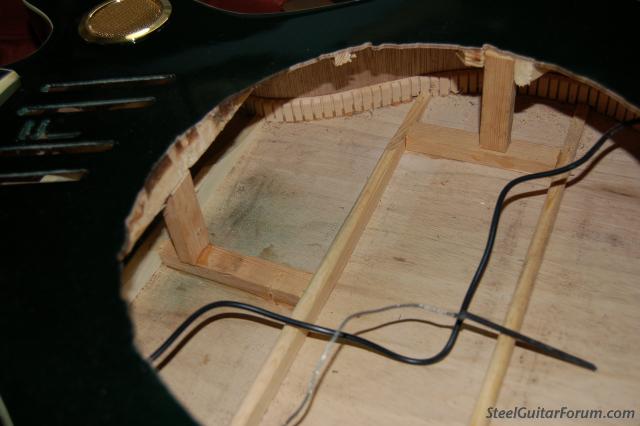| Author |
Topic: Marking Out Fingerboards |
Alan Brookes
From:
Brummy living in Southern California
|
 Posted 1 Sep 2017 5:10 pm
Posted 1 Sep 2017 5:10 pm |
|
Here's a useful method of marking out fingerboards for steel guitars. I've used this method, and methods like it, for about 50 years now.
First you calculate where the frets are going to be, given the sounding length from bridge to nut. You don't have to do the arithmetic. I already created a spreadsheet that will do that for you. Anyone who wants it, email me at afbrookes@aol.com.
Get two scrap pieces of wood of the same thickness as your fingerboard, and secure them each side with masking tape.
Then put lengths of double-sided Scotch tape on the two scrap pieces. Lay thin stips of wood where you want the fret markers to be.

Now spray the fingerboard whatever color you want it to be. I used brown on this, because it's going onto an acoustic instument that is plain wood.
The double-sided tape prevents the strips of wood from being blown away by the spray.

Now remove the scrap wood and strips, to reveal your marked-out fingerboard.

Finally give the fingerboard a few coats of varnish to protect it.

The frets will be the color of the wood that you started with. If you want frets of a different color then spray the fingerboard that color before you start.
One further thing. If you used cellulose instead of wood, then, if you install a light under the fingerboard your frets will light up in the dark. Great for dark stages. |
|
|
|
Larry Carlson
From:
My Computer
|
 Posted 2 Sep 2017 6:45 am
Posted 2 Sep 2017 6:45 am |
|
That's a neat and rather simple straight forward way of doing it.
I always turn fretboards into a science project. I hated science.
I am going to give that a try.
Thank you...... 
_________________
I have stuff.
I try to make music with it.
Sometimes it works.
Sometimes it doesn't.
But I keep on trying. |
|
|
|
Alan Brookes
From:
Brummy living in Southern California
|
|
|
|
Bill Creller
From:
Saginaw, Michigan, USA (deceased)
|
 Posted 3 Sep 2017 9:30 am
Posted 3 Sep 2017 9:30 am |
|
| Interesting idea. Luckily, a friend has a machine shop, with a CNC mill, and I made a bunch of fret boards on that, Some 22.5 scales, and some 24.5 scales, black & brown surface plastic, which shows white for the frets.. |
|
|
|
Bill Mollenhauer
From:
New Jersey, USA
|
 Posted 3 Sep 2017 12:00 pm
Posted 3 Sep 2017 12:00 pm |
|
| Alan, In looking at your resonator conversion that you mentioned previously, I don't see how you support the cone. Did you put a ledge underneath the top of the guitar or is the cone just resting on the top of the guitar or did I miss something? Thanks, Bill |
|
|
|
Alan Brookes
From:
Brummy living in Southern California
|
 Posted 4 Sep 2017 5:29 pm
Posted 4 Sep 2017 5:29 pm |
|
| Bill Mollenhauer wrote: |
| Alan, In looking at your resonator conversion that you mentioned previously, I don't see how you support the cone. Did you put a ledge underneath the top of the guitar or is the cone just resting on the top of the guitar or did I miss something? Thanks, Bill |

I put in four extra supports, which allows the guitar top to take the weight of the cone.
I've been playing the instrument almost every day over the last few years: it's more convenient as an acoustic instrument to practice C6 on than having to hook up an amplifier: I haven't noticed any sagging of the top. They are substantial supports that I put in, so I'm hoping that I won't. |
|
|
|



